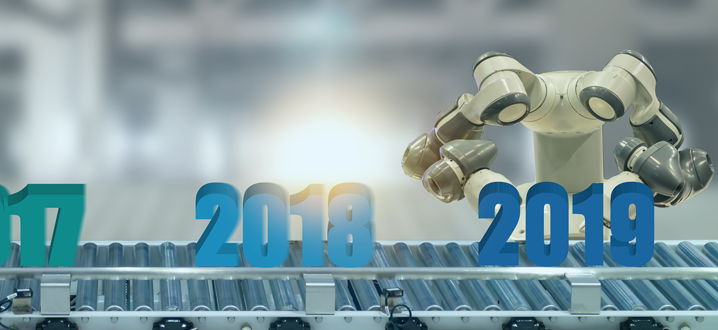Manufacturing Innovation Blog
Powered by the Manufacturing Extension Partnership

Steady industry growth was a trend for manufacturers in 2018. According to a recent Forbes report, U.S. manufacturing has rebounded since the Great Recession, with a gain of 1.1 million jobs over the last eight years. Those numbers are expected to climb in 2019.
New technologies and innovations continue to create manufacturing jobs. For instance, computer numerical control (CNC) machine advances are boosting output and efficiency metrics, leveling the productivity playing field for small and medium-sized manufacturers (SMMs).
But are manufacturers taking full advantage of these technological advances? According to a report by the McKinsey Global Institute, U.S. manufacturers could boost their overall value by 20 percent — up to $530 billion — by 2025. However, McKinsey cautions that the industry as a whole (including SMMs) must take advantage of newly available technologies and processes to achieve those numbers.
From additive manufacturing to collaborative robots, manufacturers across the country are already utilizing many of these high-tech advances, often thanks to connections they’ve forged with the MEP National NetworkTM via their local MEP Centers.
Based on these engagements, here are a few hot opportunities we recommend SMMs keep an eye on in 2019.
1. Additive Manufacturing
Advancements in additive manufacturing can help SMMs reduce energy costs, limit waste, and boost production. Plus, these technologies are becoming increasingly affordable, according to California Manufacturing Manufacturing Technology Consulting (CMTC), the MEP Center in California.
Last year, NIST MEP partnered with another program at the National Institute of Standards and Technology (NIST), the Measurement Science for Additive Manufacturing (MSAM) Program, to delve into the pros and cons of additive manufacturing. The collaboration found that, in order to reap the benefits of 3D printing, manufacturers should consider these “factoids”:
- You don’t have to buy additive manufacturing machines to try it. There are local service bureaus that can help manufacturers test before investing in equipment.
- If you are already using computer-aided design (CAD), you may be just one step away from being able to utilize additive manufacturing. If your data is already digital, it’s a simple process to link your data to additive manufacturing equipment to create prototypes.
- The NIST MSAM database provides manufacturers with the data that NIST researchers collected while sampling various materials, laser powers, laser speeds, and other factors when creating a build.
- Don’t be afraid to play with additive manufacturing. Manufacturers who have partnered with MEP Centers are already testing prototypes with promising early developments.
- Additive manufacturing is already being implemented in mold building, replacing traditional sand moldings for metal castings.
2. Collaborative Robots
The Robotics Industries Association (RIA) defines collaborative robots, also known as “cobots,” as robots specifically designed to work side-by-side with humans within a defined collaborative workspace. Along with additive manufacturing, cobot technology can be a formidable ally for SMMs trying to compete with larger operations. The RIA predicts cobot sales will reach $34 billion by 2026 as more and more manufacturers take advantage of this technology.
In anticipation of this growing demand, researchers at the NIST Robotics Test Facility are conducting ongoing robotics research, including implementing safety standards and studying the intricacies surrounding humans working side-by-side with cobots. The NIST scientists are documenting both the safety and productivity potential of cobots for manufacturing tasks such as assembly, machine tending, quality inspections, and more.
3. Smart Manufacturing
With machine learning and analytics now more readily available via CNC machines, manufacturers can use smart manufacturing to improve productivity and efficiency. In a recent MEP National Network article on the subject, “smart manufacturing” is defined as: “The practice of making information about manufacturing processes available when and where it is needed, in the form it is needed, so that smart decisions can be made about the course of critical business operations.”
Technology on its own won’t grow a business. The article suggests manufacturers should establish long-term and short-term goals for business growth, set margins to measure that growth, and only then determine what type of machines and technology they need to reach those goals.
4. Cybersecurity
Thanks to readily available cybersecurity guidelines from NIST, SMMs that don’t have a cybersecurity plan can start to protect their operations and their customers’ confidential information. For instance, while CNC machines have helped manufacturers grow, they also provide more computer access points for potential hackers and the time has come to start to address these vulnerabilities.
The Department of Defense (DoD) has set cybersecurity standards for all their contractor original equipment manufacturers (OEMs), and these rules are also applicable to smaller manufacturers that are part of the DoD supply chain. The Defense Federal Acquisition Regulation Supplement (DFARS) provides some “basic” information system security controls, and defines key terms such as “adequate security,” “proprietary information,” and “controlled technical information.”
These DoD standards are reflected in the "NIST MEP Cybersecurity Self-Assessment Handbook For Assessing NIST SP 800-171 Security Requirements in Response to DFARS Cybersecurity Requirements” developed by NIST MEP. It lays out a framework for manufacturers who must meet DFARS requirements to become (or stay) defense contractors, as well as for commercial supply chains looking for a cybersecurity roadmap for managing their organizational risks.
5. Workforce Development
Technology advances offer numerous opportunities for the future of workforce development. Even now, employees who used to do repetitive assembly or inspection tasks taken on by robots are advancing their careers into higher-level positions that require problem-solving skills.
Meanwhile, manufacturers still need a large number of skilled workers to fill job openings. According to a recent study from Deloitte and The Manufacturing Institute, skilled production, digital talent, and operational management positions may be three times as difficult to fill in the next three years, with 2.4 million positions in manufacturing going unfilled between 2018 and 2028.
Manufacturing engineers, also referred to as plant engineers or process engineers, will be in high demand in 2019 to perform cost benefit-analyses, solve production issues, and operate CAD software to design and produce products and systems. Digital twin engineers, who manage communication networks between the physical and digital worlds throughout the manufacturing value chain, are also expected to be in high demand, according to the Deloitte and The Manufacturing Institute study.
To help source talent and fill these new high-level positions, the MEP National Network offers some well-researched workforce development solutions and can provide resource connections, industry partnerships, career pathways, and other guidance for attracting existing and emerging talent.
The Future Is Now
While 2019 promises to be an interesting year in manufacturing, all of the topics above represent facets of the larger dynamics that will shape manufacturing in the decades to come. The fact is, we’re in the midst of an industrial revolution that is changing how products are designed, fabricated, used, and serviced. The implications are especially exciting for smaller manufacturers, as the ingredients for increased productivity and profitability have never been more accessible. If your company is ready to seize the opportunity, the future is now.


